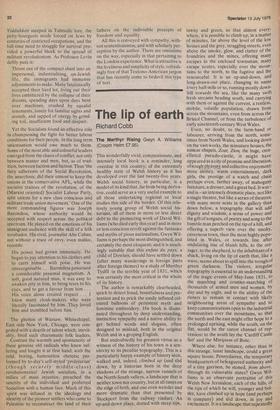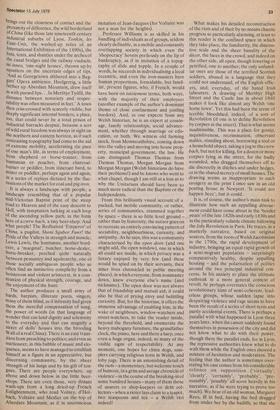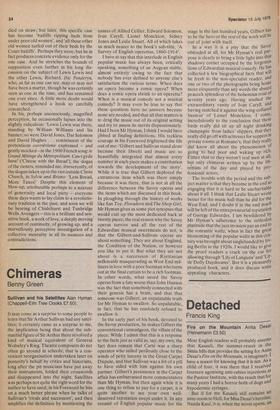The lip of earth
Richard Cobb
The Merthyr Rising Gwyn A. Williams (Groom Helm £7.95) This wonderfully vivid, compassionate, and intensely local book is a reminder, long overdue in this country, of the extremely healthy state of Welsh history as it has developed over the last twenty-five years. Welsh social history, in particular, is a model of its kind that, far from being derivative, could serve as a very useful example to all those undertaking regional or local studies this side of the border. Of this relatively young group of Welsh social historians, all of them in more or less direct debt to the pioneering work of David Williams (who died early this year) and in more or less conscious revolt against the fantasies and myths of pious nationalism, Gwyn Williams is perhaps the most distinguished, and certainly the most eloquent; and it is touchingly suitable that this enfant du pays, a child of Dowlais, should have settled down (after many wanderings in foreign parts after foreign themes) to a study of Merthyr Tydfil in the terrible year of 1831, which was certainly the most critical in the whole of its history.
The author is remarkably clearheaded, quick to detect fraud, boastfulness and pretention and to prick the easily inflated coloured balloons of persistent myth and feminine embroidery. His book is illuminated throughout by deep understanding, instinctive sympathy and a native ability to get behind words and slogans, often designed to mislead, both in the original Welsh and in a groping English.
But undoubtedly his greatest virtue as a witness of the history of his town is a sensitivity to its peculiar topography. This is a particularly happy example of history seen, walked and, indeed, climbed up (and slid down, by a historian born in the deep shadows of the strange, narrow runnels of the North-South valleys, a landscape that is neither town nor country, but at all times on the edge of both, and one even weirder and more dramatic than that presented by Stockport from the railway viaduct. An up-and-down place, dotted with steep tips, tawny and green, so that almost everywhere, it is possible to climb up, in a matter of minutes, far above the level of the low houses and the grey, straggling streets, even above the smoke, glow, and clatter of the foundries and the mines, offering many escapes to the enclosed townsman, many escape routes, especially over the mountains to the north, to the fugitive and the resourceful. It is an up-and-down, and long-drawn-out place, changing its name every half-mile or so, running mostly downhill towards the sea, like the many swift fresh streams heading south, and carrying with them or against the current, a restless, mobile, volatile population, drawn from across the mountains, even from across the Bristol Channel, or from the turbulence of early nineteenth-century West Wales.
Even, no doubt, to the farm-hand or labourer, arriving from the north, sometimes from North Wales, and looking down on the vast works, the miniature houses, the austere chapels, Zoar, Zion, the huge, crenellated pseudo-castle, it might have appeared as a c ity of promise and liberation, of•rough pleasure and collective enjoyment: more money, warm entertainment, dark girls, the prestige of a watch and chain perhaps even, farther away, of mahogany furniture, a dresser, and a great bed. It was — and is — an intensely dramatic place, not like a single theatre, but like a series of theatres, with many more seats in the gallery than down below, a topography that will add dignity and wisdom, a sense of power and the gift of tongues, of poetry and song to the humble man perched on the tip of a hill, and offering a superb view over the smoky, cavernous town, then the most highly populated in Wales, or towards line after undulating line of bluish hills, to the cottager, to the shepherd, to the inhabitant of a shack, living on the lip of earth that, like a wave, seems about to spill into the trough of green darkness. The violent, irregular topography is essential to an understanding of the tragic events of May-June 1831, to the marching and counter-marching of thousands of armed men and women, by day and by night, and to the ability of the rioters to remain in contact with likely neighbouring areas of sympathy and to keep communications open to the industrial communities over the mountains, so that the north and the east might offer hope to a prolonged uprising, while the south, on the flat, would be the surest channel of repression: to the south lay the 'Cardiff Castle Set' and the Marquess of Bute.
Where else, for instance, other than in this strange, lunar landscape, could a great square house, Pennydarren, the temporary headquarters of beleaguered authority and of a tiny garrison, be stoned, from above, through its vulnerable slates? Gwyn Williams is an observant portraitist of this Welsh New Jerusalem, each of the hills, of the tips of which he will, younger and bolder, have climbed up in hope (and perhaps in company) and slid down, in joy and excitement. It is a landscape that repeatedly brings out the closeness of contact and the Proximity of difference, the wild borderland Of China (like those late nineteenth century industrial suburbs of Lyon, Tonkin, les Etats-Unis, the washed-up relics of an International Exhibition of the 1890s), the huts, tents, and shanties under the arches of the canal bridges and the railway viaducts, tai innos, 'one-night houses', thrown up by Squatters on the uncertain edges of tips. And as Georgetown slithered into a Beggars' Opera ambience. Heolgerrig, a little farther up Aberdare Mountain, drew itself in with pursed lips. . .In Merthyr Tydfil, the distance between notoriety and respectability was often measured in feet.' A town then criss-crossed with scarcely visible, but deeply significant internal borders, a place, too, that could never be a total prison of industrial barracks despair, because a sort of wild rural freedom was always in sight on the northern and eastern horizon, as if such contrasting topography had come to the aid of extreme mobility, accelerating the pace of one man's life, in terms of employment, from shepherd or horse-trainer, from huntsman or poacher, from charcoalburner or peddler, from itinerant bard, to miner or puddler, perhaps again and again, in a series of replays dictated by the fluctuations of the market for coal and pig-iron.
It is always a landscape with people, a landscape resembling that of a popular mid-Victorian Baptist print of the steep road to Heaven and of the easy descent to Hell, with temptation lurking at each loop of the ascending yellow path, in the form here of a cwrw bach, a tiny beer-shop. And What people! The Redhaired 'Emperor' of China, a pugilist, Shoni Sgubor Fawr! the Pride of the Valleys in strength and muscle; Lewis Lewis, the huntsman, another borderer, a 'marginal', butcher, horse-dealer,
horse-breaker, perched quite naturally between peasantry and squirearchy, one of those socially ambiguous people who so Often find an instinctive complicity from a boisterous and violent aristocrat, in a communion of physical strength, courage, and the enjoyment of the hunt.
The author produces a small army of bards, harpists, illiterate poets, singers, many of them blind, as if infirmity had given them the merciful compensation of song, the power of words (in that language of Wonder that can lend dignity and solemnity to the everyday and that can magnify a street of dolls' houses into the brooding Wall of a real China). There is an easy trans ition from preaching to politics; and even an auctioneer, in this babble of music and elo quence, seems to have managed to establish himself as a figure in an appreciative, but discerning community, by the sheer strength of his lungs and by his gift of ton gues. There are people everywhere, up above and down below in the little beer shops. There are even those, very distant Wash-ups from a long dried-up French Enlightenment, who read Volney, d'Hol bach, Voltaire and Meslier on the top of Aberdare Mountain, as if in unconscious imitation of Jean-Jacques (for Voltaire was not a man for the heights).
Professor Williams is as skilled in his handling of individuals as of groups, seldom clearly definable, in a mobile and constantly overlapping society in which even the 'shopocracy' hovers perilously on the lip of bankruptcy, as if in imitation of a topog raphy of slide and topple. In a couple of words, he succeeds in individualising a local
eccentric, and even the iron-masters have human proportions, formidable, but familiar, present figures, who, if French, would have been on tutoiement terms, both ways, with the majority of their employees
(another example of the author's dominant theme of close confinement and jostling borders). And, as one expects from any Welsh historian, he is an expert at cousinage, family relationships, social advance ment, whether through marriage or edu
cation, or both, We witness old farming stock, from Monmouthshire, coming down into the valley and moving into house property, municipal government, the law. He can distinguish Thomas Thomas from Thomas Thomas, Morgan Morgan from Morgan Morgan (Welsh historians do have their problems!) and he knows who went to what chapel, though I am still at a loss as to why the Unitarians should have been so much more radical than the Baptists or the Independents.
From this brilliantly visual account cif a packed, but mobile community, or rather, series of communities, crammed together by space — there is so little level ground — rather than by fraternity, the author goes on to recreate an entirely convincing pattern of sociability, neighbourliness, curiosity, and antipathy. As he says, this was a community characterised by the open door (and one might add, the open window), one in which all could see inside, in which privacy was a luxury enjoyed by very few (and these would be spied on by their servants, their inner lives chronicled in public meeting places), in which everyone, from ironmaster down, knew everyone else's name (and nickname). The open door was not always that of friendship and mutual aid; it could also be that of prying envy and belittling curiosity. But, for the historian, it offers the immense advantage of enabling him, in the wake of neighbours, window-watchers and street-watchers, to take the reader inside, beyond the threshold, and enumerate the
heavy mahogany furniture, the grandfather clock, the piano, here and there a harp, once even a huge organ, indeed, so many of the visible signs of respectability. At any moment, one hopes for china dogs, sam plers carrying religious texts in Welsh, and toby jugs. There is an astonishing detail of the riots — a momentary, but welcome touch of humour, in a grim and savage chronicle of violence —in the course of the breaking-in of some hundred houses —many of them those
of usurers or shop-keepers or debt collectors—when a rioter lays claim to a teapot, two teaspoons and tea — a Welsh riot indeed! What makes his detailed reconstruction of the riots and of their by no means chaotic progress so particularly alarming, at least to this reader is the confined space in which they take place, the familiarity, the diminutive scale and the sheer banality of the decor, the faces in the crowd, and indeed on the other side, all open, though lowering or petrified, one to another; the only unfamiliar ones are those of the terrified Scottish soldiers, abused in a language that they could not understand, of the English officers, and, everyday, of the hated Irish labourers. A drawing of Merthyr High Street and the Castle Inn in about 1840 makes it look like almost any Welsh 'one horse town'. Yet this had been the scene of terrible bloodshed, indeed, of a sort of Revolution (if one is to define Revolution by corpses in the street). That is what seems inadmissible. This was a place for gossip, inquisitiveness, recrimination, observant malice, standing about, borrowing a tool or a household object, taking a jug to the cwrw bach, but not for killing, for a dozen or more corpses lying in the street, for the badly wounded, who dragged themselves off to die discreetly in ditches and under hedges, or in the shared secrecy of small houses. The drawing seems as inappropriate to ,such savagery as the print I once saw in an old posting house in Newport. 'It could not happen here'; but it could.
It is, of course, the author's main task to illustrate how such an appalling denoue ment could have come about in the 'border years' of the late 1820s and early 1830s and
in the particularly volatile climate following the July Revolution in Paris. He traces, in a masterly narrative, based on original sources, from the roots of Welsh Jacobin ism in the 1790s, the rapid development of industry, bringing an equal rapid growth of a semi-migrant population — surprisingly comparatively healthy, despite appalling housing — and the polarisation of politics around the two principal industrial concerns. In his anxiety to place the ultimate outbreak in a more general context of revolt, he perhaps overstates the conscious revolutionary aims of semi-coherent, lead erless groups, whose sudden lapse into despairing violence and rage seems to have been the result of a series of short-term and partly accidental events. There is perhaps a parallel with what happened in Lyon three
years later, when the canuts suddenly found
themselves in possession of the city and did not know what to do with their power, though there the parallel ends, for in Lyon, the repressive authorities knew what to do with them while the English ones showed a mixture of hesitation and moderation. The feeling that the author is sometimes over stating his case comes from his considerable reliance on supposition ('virtually', 'clearly', 'certainly', 'probably', 'pre sumably', 'possibly' all score heavily in his narrative, as if he were trying to prove too much). We hear of an old woman, Margaret Rees, ill in bed, having the bed dragged from under her by the bailiffs, so that she died on straw; but later, this specific case has become 'bailiffs ripping beds from under poor old women', and 'all those other old women turfed out of their beds by the Court bailiffs'. Perhaps they were; but he in fact produces concrete evidence only for the one case. And he stretches the bounds of supposition even further in his long discussion on the subject of Lewis Lewis and the other Lewis, Richard, Dic Penderyn, who, as far as one can see, may or may not have been a martyr, though he was certainly seen as one at the time, and has remained one ever since. A little more doubt would have strengthened a book so carefully researched.
In his, perhaps unconsciously, magnified! perception, he occasionally lapses into the slightly ridiculous: 'Lewis Lewis was there, standing by William Williams and his banner; so were David Jones, Dai Solomon and David Hughes . , . reminiscent of the portentious ouvrierisme expressed — and gently mocked — in the 1900 French song: le Grand Mitinge du Metropolitain. Caws gyda bara! ('Cheese with the Bread'), the slogan of the rioters, reminded me, irreverently, of the slogan taken up in the riot outside Christ Church, in Sylvie and Bruno: 'Less Bread, More Taxes!' Despite this element of blow-up, attributable perhaps to a mixture of generosity and local piety — everyone these days wants to lay claim to a revolutionary tradition in the past, and soon we will be hearing of Chislehurst and Tunbridge Wells Avengers — this is a brilliant and sensitive book, a work of love, a deeply moving account of continuity, of growing up, and a marvellously perceptive investigation of a collective mentality in all its nuances and contradictions.




































 Previous page
Previous page